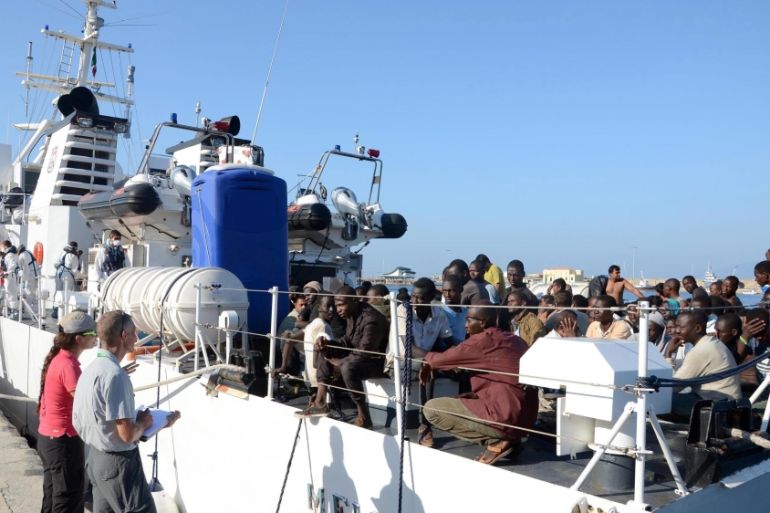A day aboard a rescue boat in the Mediterranean
As Europe grapples with a massive refugee crisis, MSF doctors keep watch over the dangerous sea crossing.

Mediterranean Sea – Abdugai sits on the floor of the Dignity I rescue boat in the Mediterranean Sea, making his way towards the Italian town of Augusta after a treacherous journey that has stretched over a year.
It is on this floor that Abdugai, who fled Gambia for reasons that he did not say, will pass the night, along with dozens of other refugees from sub-Saharan Africa. After staying in Libya for a year, trying to save up enough money to pay for his passage to Italy, Abdugai, who did not provide a last name, left after Libya’s civil war escalated
Keep reading
list of 4 itemsEcuador spat: Trotsky to the shah, Mexico’s long history as home to exiles
Mandela’s world: A photographic retrospective of apartheid South Africa
‘Profoundly unjust’: Reactions to court overturning Weinstein’s conviction
The first time he tried to cross the Mediterranean, Abdugai was arrested by Libyan soldiers and placed in a detention centre, where he said hundreds of others were packed into large rooms with no water or electricity.
“Libyan soldiers took everything from us: the bit of money we had left and our mobile phones,” Abdugai told Al Jazeera. “They used the phones to blackmail our families… Luckily, my relatives knew a man in Tripoli who could pay for me. They freed me and I had to pay my smugglers again. Then I left.
|
|
“This second chance cost me 1,500 dinars [$1,100],” he added. “Libyan smugglers have no qualms. They don’t even care if you are a child.”
On his second attempt to cross the sea on a raft, Abdugai was rescued by the crew of the Dignity I.
OPINION: Europe’s light bulb moment
Dignity I, one of three Doctors Without Borders (MSF) rescue boats that have been traversing the Mediterranean in search of refugees, weighed anchor more than two months ago from the Spanish city of Barcelona. On a recent afternoon, the boat was carrying 300 refugees and 20 crew members, including doctors, interpreters, and mediators.
Francesca Mangia, who leads the MSF mission aboard Dignity I, said the rescue teams have been grappling with trends of increasing violence and cynicism among smugglers, who send refugees out to sea on unsafe crafts.
“With each rubber boat that we come across, we realise that the situation is worsening,” Mangia told Al Jazeera. “The reports are always the same: brutalities, torture.”
In particular, the number of women and children who have been suffering violence at the hands of smugglers and security forces has been on the rise, Mangia said.
“Everyday we meet entire families who have suffered inconceivable violence,” she said. “A couple of weeks ago, we rescued a child with multiple fractures. He told us the smugglers beat him up because he didn’t want to get on board.”
MSF works in conjunction with the Italian coastguard, which provides operational support, either by identifying vessels in distress and communicating the location to MSF, or by helping to ascertain the condition and needs of the passengers aboard vessels spotted by MSF surveillance teams.
There are many traumatised men and women, and when you reach the boat to take them on board, they all stand up and the boat risks capsizing. We have to be very careful and we can't make any mistake; if they fall in the water, they risk dying.
“Every rubber boat presents different problems,” said an MSF staff member who declined to provide his name, as he was not authorised to speak to the media. “There are many traumatised men and women, and when you reach the boat to take them on board, they all stand up and the boat risks capsizing. We have to be very careful and we can’t make any mistakes; if they fall into the water, they risk dying.
“We have to calm them down,” he added. “We have to explain that we are there to rescue them. We often approach them with two boats to show them that there’s a place for everyone.”
It takes more than 30 hours by sea to go from the Libyan coast to Sicily, during which the MSF crew provides rescued refugees with medical assistance and meals. When they eventually reach Sicily, refugees are treated by a team of doctors, nurses and psychologists, as needed.
Ulet Mohamed, a 15-year-old boy from Somalia, was supposed to be on board the Dignity I looking towards the Italian coastline and a brighter future. But after suffering beatings at the hands of smugglers, his body gave out only a few minutes after the MSF crew rescued him, staff onboard the boat told Al Jazeera.
European countries have been grappling with how to handle the massive refugee influx, but as the issue continues to generate debate, the body count in the Mediterranean continues to rise.
“I don’t know if we are talking about a sort of incapability to understand this context, or maybe it’s just a matter of incapability to intervene,” Mangia said. “[But] there is a strong humanitarian, political and social necessity. And we must address these issues.”
As Mangia gazes towards the horizon, her exhaustion is clear. She speaks of the endless need and the fear of not being able save all the refugees who have been attempting the dangerous Mediterranean crossing.
“This forces us to go on and on,” she said, “to go on helping people – to communicate that it is necessary to find a shared solution”.
The Dignity I eventually reaches Sicily with its 300 passengers all accounted for. They disembark and prepare to look for a better future.
Except for one: MSF staff unload Mohamed’s body and prepare to contact a Sicilian association that has agreed to make arrangements for his funeral.